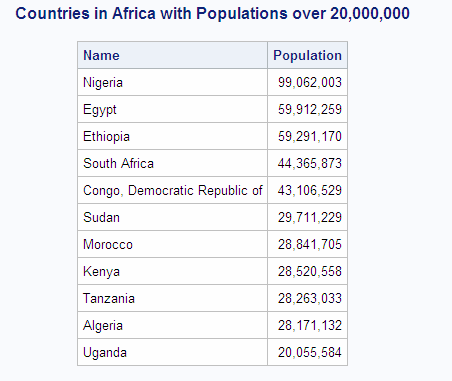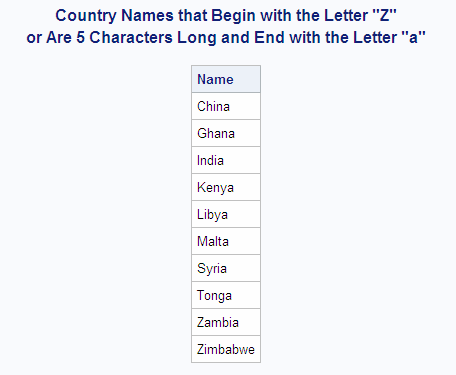Retrieving Rows That Satisfy a Condition
The WHERE clause enables you to retrieve only rows
from a table that satisfy a condition. WHERE clauses can contain any
of the columns in a table, including columns that are not selected.
Using a Simple WHERE Clause
Retrieving Rows Based on a Comparison
You can use comparison operators in a WHERE clause to
select different subsets of data. The following table lists the comparison
operators that you can use:
The following example
subsets the SQL.UNITEDSTATES table by including only states with populations
greater than 5,000,000 people:
Retrieving Rows That Satisfy Multiple Conditions
You can use logical, or Boolean, operators to construct
a WHERE clause that contains two or more expressions. The following
table lists the logical operators that you can use:
The following example
uses two expressions to include only countries that are in Africa
and that have a population greater than 20,000,000 people:
Using Other Conditional Operators
Overview of Using Other Conditional Operators
You can use many different
conditional operators in a WHERE clause. The following table lists
other operators that you can use:
|
tests for values that
match a specified pattern
(footnote1)
|
||
Using the IN Operator
The IN operator enables you to include values within
a list that you supply. The following example uses the IN operator
to include only the mountains and waterfalls in the SQL.FEATURES table:
Using the IS MISSING Operator
The IS MISSING operator enables you to identify rows
that contain columns with missing values. The following example selects
countries that are not located on a continent. That is, these countries
have a missing value in the Continent column:
Using the BETWEEN-AND Operators
To select rows based on a range of values, you can use
the BETWEEN-AND operators. This example selects countries that have
latitudes within five degrees of the Equator:
proc sql outobs=12;
title 'Equatorial Cities of the World';
select City, Country, Latitude
from sql.worldcitycoords
where Latitude between -5 and 5;Note: In the tables used in these
examples, latitude values that are south of the Equator are negative.
Longitude values that are west of the Prime Meridian are also negative.
Using the LIKE Operator
The LIKE operator enables you to select rows based on
pattern matching. For example, the following query returns all countries
in the SQL.COUNTRIES table that begin with the letter Z and
are any number of characters long, or end with the letter a and
are five characters long:
libname sql 'SAS-library';
proc sql;
title1 'Country Names that Begin with the Letter "Z"';
title2 'or Are 5 Characters Long and End with the Letter "a"';
select Name
from sql.countries
where Name like 'Z%' or Name like '____a';The percent sign (%)
and underscore (_) are wildcard characters. For more information about
pattern matching with the LIKE comparison operator, see SQL Procedure.
Using Truncated String Comparison Operators
Truncated string
comparison operators are used to compare two strings. They differ
from conventional comparison operators in that, before executing the
comparison, PROC SQL truncates the longer string to be the same length
as the shorter string. The truncation is performed internally; neither
operand is permanently changed. The following table lists the truncated
comparison operators:
Using a WHERE Clause with Missing Values
If a column that you specify in a WHERE clause contains
missing values, then a query might provide unexpected results. For
example, the following query returns all features from the SQL.FEATURES
table that have a depth of less than 500 feet:
libname sql 'SAS-library';
/* incorrect output */
proc sql outobs=12;
title 'World Features with a Depth of Less than 500 Feet';
select Name, Depth
from sql.features
where Depth lt 500
order by Depth;However, because PROC
SQL treats missing values as smaller than nonmissing values, features
that have no depth listed are also included in the results. To avoid
this problem, you could adjust the WHERE expression to check for missing
values and exclude them from the query results, as follows:
FOOTNOTE 1:You
can use a percent symbol (%) to match any number of characters. You
can use an underscore (_) to match one arbitrary character.[return]
Copyright © SAS Institute Inc. All rights reserved.









